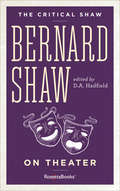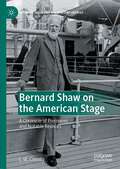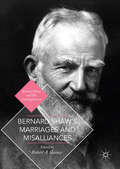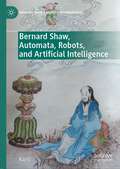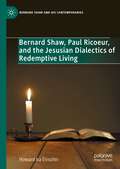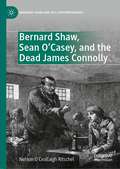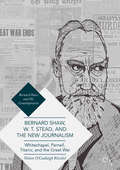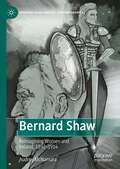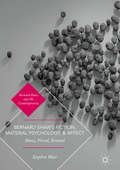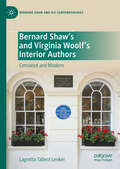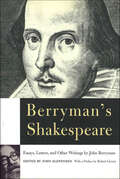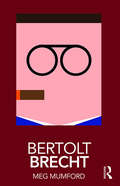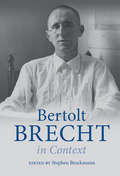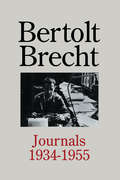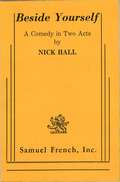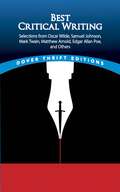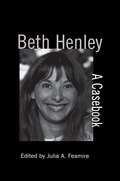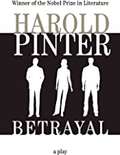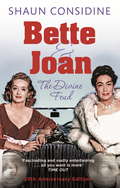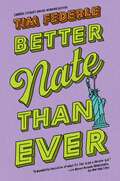- Table View
- List View
Bernard Shaw on Theater: On Theater (The Critical Shaw)
by George Bernard ShawA collection of critical writings on theater from the Nobel Prize–winning playwright behind Man and Superman and Pygmalion.The Critical Shaw: On Theater is a comprehensive selection of essays and addresses about drama and theater by renowned Irish playwright and Nobel Laureate Bernard Shaw. An outspoken critic of the melodramas and formulaic farces that comprised most of the popular theater in the late nineteenth century, Shaw relentlessly campaigned for audiences, actors, theater managers, and even government officials to take theater more seriously, to use the stage as a forum for representing complex real issues such as poverty, marriage and divorce laws, sexual attraction, gender equality, and political power, so that through seeing them acted out, audiences could better understand and address them when they left the theater. Shaw&’s commitment to social reform through theater was matched by his expertise in the artistic and practical aspects of drama: whether he was reviewing productions, lecturing about acting, or schooling agents on royalties and copyright law, Shaw set a standard for intelligent professionalism that our own theaters might still aspire to and be measured against.The Critical Shaw series brings together, in five volumes and from a wide range of sources, selections from Bernard Shaw&’s voluminous writings on topics that exercised him for the whole of his professional career: Literature, Music, Politics, Religion, and Theater. The volumes are edited by leading Shaw scholars, and all include an introduction, a chronology of Shaw&’s life and works, annotated texts, and a bibliography. The series editor is L.W. Conolly, literary adviser to the Shaw Estate and former president of the International Shaw Society.
Bernard Shaw on the American Stage: A Chronicle of Premieres and Notable Revivals (Bernard Shaw and His Contemporaries)
by L. W. ConollyBernard Shaw on the American Stage is the first comprehensive study of the production of Bernard Shaw’s plays in America. During his lifetime (1856-1950), Shaw was America’s most popular living playwright; productions of his plays were outnumbered only by Shakespeare. Forty-four of Shaw’s plays were staged in America before his death, eight more posthumously. Eleven of the productions were world premieres. Bernard Shaw on the American Stage tells the story of the fifty-two premieres, which, apart from a few fragments, is his total dramatic oeuvre. The book also includes, again for the first time, production data and concise overviews of dozens of the most notable American revivals of the plays, from the 1890s to the beginning of the 2020 pandemic. Illustrations—production photographs, programmes, theatre buildings, playbills, actors’ studio portraits— inform the study throughout.
Bernard Shaw's Marriages and Misalliances (Bernard Shaw and His Contemporaries)
by Robert A. GainesThis book combines the insights of thirteen Shavian scholars as they examine the themes of marriage, relationships and partnerships throughout all of Bernard Shaw's major works. It also connects Shaw's own experiences of love and marriage to the themes that emerge in his works, showing how his personal relationships in and out of matrimonial bonds change the ways his characters enter and exit marriages and misalliances. While providing a wealth of new analysis, this collection of essays also leaves lingering questions for the reader to spark continuing dialogue in both individual and academic settings.
Bernard Shaw, Automata, Robots, and Artificial Intelligence (Bernard Shaw and His Contemporaries)
by Kay LiThis project is the first to explore how Bernard Shaw intersects constructively with automata, robots and artificial intelligence (AI). Shaw was born in the golden age of the automaton. His Bible on the Life Force and Creative Evolution, Back to Methuselah, was written when Karel and Josef Čapek coined the word “robot.” Shaw’s life ran in parallel with the rise of AI, and the big names in AI were his contemporaries. Moreover, empirical analyses of Shavian texts and images using AI uncovers possibilities for new interpretations, demonstrating how future renditions of his works may make use of these advanced technologies to broaden Shaw’s audience, readership and scholarship.
Bernard Shaw, Paul Ricoeur, and the Jesusian Dialectics of Redemptive Living (Bernard Shaw and His Contemporaries)
by Howard Ira EinsohnThis book explores a heretofore unremarked linkage between Bernard Shaw, the twentieth-century French thinker Paul Ricoeur, and Jesus of Nazareth. The ties that bind them are a foundational interest in the social teachings of the Nazarene and their use of a shared dialectics with respect to living the kind of compassionate life that holds out the promise in our contemporary world of achieving something approximating universal wellness on a healthy planet at peace with itself. This work argues that the three principal subjects of the study—independently of one another—used the same dialectical method to reach the same dialectically derived conclusion about how humans can live redemptively in a fractured world.
Bernard Shaw, Sean O’Casey, and the Dead James Connolly (Bernard Shaw and His Contemporaries)
by Nelson O’Ceallaigh RitschelThis book details the Irish socialistic tracks pursued by Bernard Shaw and Sean O’Casey, mostly after 1916, that were arguably impacted by the executed James Connolly. The historical context is carefully unearthed, stretching from its 1894 roots via W. B. Yeats’ dream of Shaw as a menacing, yet grinning sewing machine, to Shaw’s and O’Casey’s 1928 masterworks. In the process, Shaw’s War Issues for Irishmen, Annajanska, the Bolshevik Empress, The Tragedy of an Elderly Gentleman, Saint Joan, The Intelligent Woman’s Guide to Socialism and Capitalism, and O’Casey’s The Story of the Irish Citizen Army, The Shadow of a Gunman, Juno and the Paycock, The Plough and the Stars, and The Silver Tassie are reconsidered, revealing previously undiscovered textures to the masterworks. All of which provides a rethinking, a reconsideration of Ireland’s great drama of the 1920s, as well as furthering the knowledge of Shaw, O’Casey, and Connolly.
Bernard Shaw, W. T. Stead, and the New Journalism
by Nelson O'Ceallaigh RitschelThis book explores Bernard Shaw’s journalism from the mid-1880s through the Great War—a period in which Shaw contributed some of the most powerful and socially relevant journalism the western world has experienced. In approaching Shaw’s journalism, the promoter and abuser of the New Journalism, W. T. Stead, is contrasted to Shaw, as Shaw countered the sensational news copy Stead and his disciples generated. To understand Shaw’s brand of New Journalism, his responses to the popular press’ portrayals of high profile historical crises are examined, while other examples prompting Shaw’s journalism over the period are cited for depth: the 1888 Whitechapel murders, the 1890-91 O’Shea divorce scandal that fell Charles Stewart Parnell, peace crusades within militarism, the catastrophic Titanic sinking, and the Great War. Through Shaw’s journalism that undermined the popular press’ shock efforts that prevented rational thought, Shaw endeavored to promote clear thinking through the immediacy of his critical journalism. Arguably, Shaw saved the free press.
Bernard Shaw: A Reassessment
by Colin WilsonThe author devotes much thought to Shaw's formative years, 20-30, and how his novels built up the Shaw persona, and how his success changed him.
Bernard Shaw: Reimagining Women and Ireland, 1892–1914 (Bernard Shaw and His Contemporaries)
by Audrey McNamaraShaw emerged as a playwright in the politically charged environment of 1892, for both female suffrage and Irish independence. His plays quickly advocated for societal changes with regard to women’s roles, while expanding this advocacy into considerations of Ireland. Shaw’s engagement with marriage and union as a personal contract with nationhood have never before been considered as a methodology with which to view his work. This book demonstrates that Shaw was deeply engaged with and committed to the Irish question and to social and gender issues.
Bernard Shaw: Volume 1, 1856-1898, The Search for Love
by Michael HolroydBiography of George Bernard Shaw from his birth to his marriage at age 42.
Bernard Shaw: Volume 2, 1898-1918, The Pursuit of Power
by Michael HolroydBiography of George Bernard Shaw from age 42 to age 62, at the height of his career.
Bernard Shaw: Volume 3, 1918-1951, The Lure of Fantasy
by Michael HolroydBiography of George Bernard Shaw, from World War I to his death at age 94.
Bernard Shaw’s Fiction, Material Psychology, and Affect: Shaw, Freud, Simmel (Bernard Shaw And His Contemporaries Ser.)
by Stephen WattThis book traces the effects of materiality - including money and its opposite, poverty - on the psychical lives of George Bernard Shaw and his characters. While this study focuses on the protagonists of the five novels Shaw wrote in the late 1870s and early 1880s, it also explores how materialism, feeling, and emotion are linked throughout his entire canon. At the same time, it demonstrates how Shaw’s conceptions of human subjectivity parallel those of two of his contemporaries, Sigmund Freud and Georg Simmel. In particular, this book explores how theories of so-called 'marginal economics' influence fin de siècle thought about human psychology and the sociology of the modern metropolis, particularly London.
Bernard Shaw’s and Virginia Woolf’s Interior Authors: Censored and Modern (Bernard Shaw and His Contemporaries)
by Lagretta Tallent LenkerVirginia Woolf and Bernard Shaw may be the odd couple of Twentieth Century modernism. Despite their difference in age (Shaw was twenty-six years older than Woolf), and public demeanor - Shaw sought public attention while Woolf shunned the spotlight - they actively held similar convictions on most of the pressing and controversial issues of the day. This book demonstrates that both engaged in social reform through the Fabian Society; both took public anti-war positions and paid dearly for it; both fought British censorship throughout most of their careers as writers; both sought to strengthen women’s rights; and both endeavored to revolutionize their respective art forms, believing that art could bring about positive social change. The main focus of the book, however, concerns how both also created interior authors - characters who write and who either self-censor their own works or highly publicized messages or are censored by their fellow characters. These fictional authors maybe considered reflections of their creators and their respective milieus and serve to illuminate the satisfactions and torments of each famous author during the writing process.
Berryman's Shakespeare: Essays, Letters, and Other Writings
by John BerrymanEdited by John HaffendenWith a Preface by Robert GirouxJohn Berryman, one of America's most talented modern poets, was winner of the Pulitzer Prize for 77 Dream Songs and the National Book Award for His Toy, His Dream, His Rest. He gained a reputation as an innovator whose bold literary adventures were tempered by exacting discipline. Berryman was also an active, prolific, and perceptive critic whose own experience as a major poet served to his advantage. Berryman was a protégé of Mark Van Doren, the great Shakespearean scholar, and the Bard's work remained one of his most abiding passions--he would devote a lifetime to writing about it. His voluminous writings on the subject have now been collected and edited by John Haffenden.
Bertolt Brecht (Routledge Performance Practitioners)
by Meg MumfordBertolt Brecht’s methods of collective experimentation, and his unique framing of the theatrical event as a forum for change, placed him among the most important contributors to the theory and practice of theatre. His work continues to have a significant impact on performance practitioners, critics and teachers alike. Now revised and reissued, this book combines: an overview of the key periods in Brecht’s life and work a clear explanation of his key theories, including the renowned ideas of Gestus and Verfremdung an account of his groundbreaking 1954 production of The Caucasian Chalk Circle an in-depth analysis of his practical exercises and rehearsal methods. As a first step towards critical understanding, and as an initial exploration before going on to further, primary research, Routledge Performance Practitioners are an invaluable resource for students and scholars.
Bertolt Brecht in Context (Literature in Context)
by Stephen BrockmannBertolt Brecht in Context examines Brecht's significance and contributions as a writer and the most influential playwright of the twentieth century. It explores the specific context from which he emerged in imperial Germany during the late nineteenth and early twentieth centuries, as well as Brecht's response to the turbulent German history of the twentieth century: World Wars One and Two, the Weimar Republic, the Nazi dictatorship, the experience of exile, and ultimately the division of Germany into two competing political blocs divided by the postwar Iron Curtain. Throughout this turbulence, and in spite of it, Brecht managed to remain extraordinarily productive, revolutionizing the theater of the twentieth century and developing a new approach to language and performance. Because of his unparalleled radicalism and influence, Brecht remains controversial to this day. This book – with a Foreword by Mark Ravenhill – lays out in clear and accessible language the shape of Brecht's contribution and the reasons for his ongoing influence.
Bertolt Brecht und Ernst Toller
by Thorsten Unger Kirsten Reimers Lydia MühlbachBertolt Brecht und Ernst Toller zählen zu den wichtigsten Dramenautoren der Weimarer Republik. Politisch gab es zu Lebzeiten zahlreiche Berührungspunkte zwischen beiden, und ebenso finden sich hinsichtlich ihres ästhetisch avancierten Anspruchs mit experimentellen Impulsen keineswegs nur im Feld von Theater und Drama Berührungspunkte. Dennoch lassen sich kaum Belege eines intensiveren Austauschs der Autoren finden. Ein Blick in die Forschung erweckt den Eindruck, hier setze sich dieses Schweigen fort. Dieser Band unternimmt es zum ersten Mal, die beiden Autoren und Œuvres zu vergleichen. Der Schwerpunkt liegt auf den Dramen und der Dramenästhetik, aber auch Lyrik, Rundfunk, Frauenrollen, kollaboratives Arbeiten und Kanonfragen sind Themen der 20 Beiträge.
Bertolt Brecht: Journals 1934 - 1955 (Diaries, Letters And Essays Ser.)
by Bertolt BrechtThis book contains selected poems, plays, and prose by Bertolt Brecht taken from various points throughout his career. It includes translations of two prose works and provides some background information on Brecht's life and career.
Beside Yourself
by Nick HallComedy / 2m, 2f / The ultimate mistaken identity comedy! Four actors each play two parts twins. Some married, some single, all amusingly characterized are at a motel for a study of human behavior. What a study! It takes only one twin wanting an extra marital fling to set off a hilarious chain reaction. Not only is there predictable, farcical confusion, but also a stunning surprise. A comic tour de force about who we are now. "Takes the mistaken identity ploy, gives it an imaginative contemporary twist and puts it to delightful use. . . . Uncommonly enjoyable." Miami Herald. . "Delightfully funny. But outside of the laughs, and there are many, the play also says a lot about human behavior. Beside Yourself is one of the finest ever presented in dinner theatre." Hollywood Sun Tattler. . "Hilarious, a fun filled, lightweight romp." Miami Sun Sentinel.. FEE: $75 per performance.
Best Critical Writing: Selections from Oscar Wilde, Samuel Johnson, Mark Twain, Matthew Arnold, Edgar Allan Poe, and Others (Dover Thrift Editions)
by John Grafton Nora RawnIn "The Critic as Artist," Oscar Wilde declares that the critic's artistic capabilities are as important as those of the artist. Wilde's passionate defense of the aesthetics of art criticism is among the wide-ranging and thought-provoking essays of this original collection, in which noted writers discuss the role of criticism in English and American literature. Contents include Edgar Allan Poe's "The Philosophy of Composition," in which the author draws upon his most famous poem, "The Raven," to illustrate his theories on writing; Matthew Arnold's "The Study of Poetry"; and commentaries on Shakespeare's plays by Samuel Johnson and Wordsworth's poetry by William Hazlitt. Walter Pater, whose work was highly influential on the writers of the Aesthetic Movement, is represented by an essay on style. Other selections include Mark Twain's satirical "Fenimore Cooper's Literary Offences" and the "Preface to Leaves of Grass" by Walt Whitman. Brief introductory notes accompany each essay.
Beth Henley: A Casebook (Casebooks on Modern Dramatists #33)
by Julia A. FesmireBeth Henley was awarded the Pulitzer Prize in Drama and the New York Drama Critics Circle Award for Best American Play for her first full-length play, Crimes of the Heart, yet there has been no book-length consideration of her body of work until now. This volume includes original essays that contextualize and analyze her works from a variety of perspectives, focusing on her vexed status as a southern writer, her use of the comic grotesque, and her alleged feminist critiques of modern society. Receiving special attention are lesser-known plays which are crucial to understanding Henley's development as a playwright and postmodern thinker.
Betrayal
by Harold PinterUpon its premiere at the National Theatre, Betrayal was immediately recognized as a masterpiece. It won the Olivier Award for best new play, and has since been performed all around the world and made into an Academy Award-nominated film starring Jeremy Irons, Ben Kingsley, and Patricia Hodge. Betrayal begins with a meeting between adulterous lovers, Emma and Jerry, two years after their affair has ended. During the nine scenes of the play, we move back in time through the stages of their affair, ending in the house of Emma and her husband Robert, Jerry’s best friend.
Bette And Joan: Divine Feud
by Shaun Considine'An absolute must-read' VANITY FAIRBette Davis and Joan Crawford: two of the deadliest arch-rivals of all time. Born in the same year (though Davis swore 'Crawford is five years older than me if she's a day'), the two fought bitterly throughout their long and brilliant Hollywood careers. Joan became a star first, which always irked her rival, who suggested her success had come via the casting couch. 'It sure as hell beats the hard cold floor' was Crawford's scathing response. According to Davis, Crawford was not only a nymphomaniac but also 'vain, jealous and about as stable and trustworthy as a basket of snakes'. Crawford, in turn, accused Davis of stealing her glory and planning to destroy her.The two rivals fought over as many men as they did parts - when Bette fell in love with her co-star in DANGEROUS, Franchot Tone, Joan stepped in and married him. The women worked together only once, in the classic thriller WHATEVER HAPPENED TO BABY JANE?, in which their violent hatred of each other as rival sisters was no act.'Shaun Considine's story of the two divas is vastly informative and in parts hilarious' SUNDAY TELEGRAPH'Fascinating and vastly entertaining . . . all you want is more' TIME OUT 'Considine's well-researched book is an account of one of Hollywood's most extraordinary relationships' DAILY EXPRESS '[A] Scurrilously readable twin biography' MAIL ON SUNDAY'Considine's dual biography is a guilty pleasure' SUNDAY HERALD'Brilliant, outrageous and hysterical' Suranne Jones (Star of BBC One's Doctor Foster)
Better Nate Than Ever: Better Nate Than Ever; Five, Six, Seven, Nate!; Nate Expectations (Nate)
by Tim FederleA small-town boy hops a bus to New York City to crash an audition for E.T.: The Musical. <P><P>Nate Foster has big dreams. His whole life, he's wanted to star in a Broadway show. (Heck, he'd settle for seeing a Broadway show.) But how is Nate supposed to make his dreams come true when he's stuck in Jankburg, Pennsylvania, where no one (except his best pal Libby) appreciates a good show tune? With Libby's help, Nate plans a daring overnight escape to New York. There's an open casting call for E.T.: The Musical, and Nate knows this could be the difference between small-town blues and big-time stardom. <P><P>Tim Federle writes a warm and witty debut that's full of broken curfews, second chances, and the adventure of growing up--because sometimes you have to get four hundred miles from your backyard to finally feel at home.
